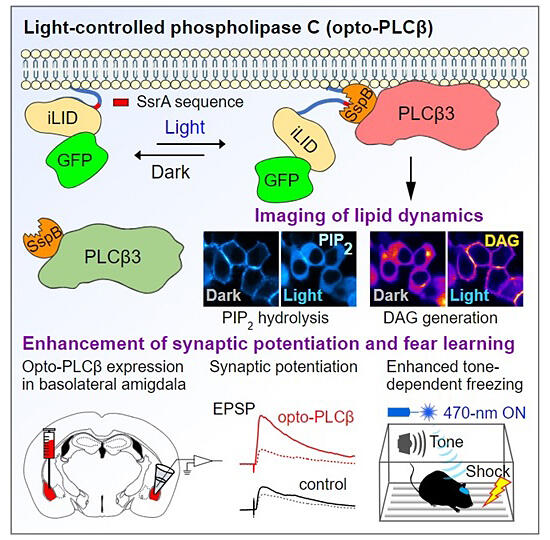The research group of Specially Appointed Assistant Professor Yeon-Jeong Kim, Assistant Professor Shun Hamada, and Professor Toshihisa Ohtsuka of the Department of Biochemistry, Interdisciplinary Graduate School of Medicine, Faculty of Medicine at the University of Yamanashi in collaboration with Professor Ayako Watabe of the Institute of Clinical Medicine and Research, Research Center for Medical Sciences at the Jikei University School of Medicine, announced the development of "light-driven phospholipase Cβ (opto-PLCβ)," a technology to manipulate cell lipid signals freely with light.
Blue light irradiation cleaves phospholipids (phosphatidylinositol: PIP2) on the cell membrane and converts them to inositol triphosphate (IP3) and diacylglycerol (DAG), which are known intracellular second messengers. Increasing intracellular calcium ion concentrations and regulating lipid bilayer dynamic fluctuations and signal transduction becomes possible. They confirmed that blue light can induce synaptic plasticity and enhance fear memory formation in the brain of mice expressing opto-PLCβ. The technology is expected to contribute to research in the brain science field. The results were published in the international academic journal Cell Chemical Biology on April 6.

Provided by the University of Yamanashi
Living organisms use hormones, neurotransmitters, and other chemicals to transmit information between cells. These chemicals are called first messengers. When they bind to receptors on the cell membrane, they produce other chemicals in the cell called second messengers. Second messengers regulate various functions in the cell. In recent years, "photogenetics" has emerged, in which cellular activities are controlled by light using light-activated proteins. However, until recently, no method existed to directly control phospholipase C, the enzyme that produces the second messengers IP3 and DAG from PIP2, using light.
To address this issue, the research group developed "opto-PLCβ," a combination of a light-activated protein and a protein anchored to the cell membrane. Blue light irradiation activates the molecule, which degrades PIP2 on the cell membrane into IP3 and DAG. This cleavage activates intracellular signaling in neurons, which can alter cellular functions leading to memory formation.
Using the same technique, they irradiated opto-PLCβ-expressing cells with blue light and were able to visualize a decrease in PIP2 and an increase in DAG simultaneously. Furthermore, they have successfully visualized changes in cell membrane lipids and increases in intracellular calcium concentration by light-dependent activation of opto-PLCβ. They also induced synaptic plasticity by blue light in mouse brains, where opto-PLCβ is expressed. When blue light was exposed to mice expressing opto-PLCβ in the basolateral nucleus of the amygdala, which is important for the formation of fear memory, the formation of fear memory was enhanced compared to mice that did not express opto-PLCβ.
Using this technology, it is possible to pinpoint and manipulate intracellular PLC activity by controlling the timing and location of light exposure. The use of light to control neural circuits in the brain involved in memory formation and neuronal excitatory transmission may be useful in elucidating the mechanisms of memory and developing treatments for neurological diseases. Furthermore, light is expected to be applied to inhibit the growth of cancer cells and control gene expression.
Ohtsuka said, "It took us 5 years to start from scratch. It is the world's first light-driven tool for phospholipase C, which produces IP3 and diacylglycerol that play important roles as second messengers. We believe it will be a useful manipulating tool because it has extremely high temporal and spatial resolution and can also stimulate intracellular domains separately such as the cell body, dendrites, and axons of neurons. Because the phospholipase C signaling pathway plays an essential role in general cellular functions, it is expected to have a wide range of applications and developments in neuropsychiatric disorders, inflammation, immunology, cancer, and drug screening."
Journal Information
Publication: Cell Chemical Biology
Title: A light-controlled phospholipase C for imaging of lipid dynamics and controlling neural plasticity
DOI: 10.1016/j.chembiol.2024.03.001
This article has been translated by JST with permission from The Science News Ltd. (https://sci-news.co.jp/). Unauthorized reproduction of the article and photographs is prohibited.




